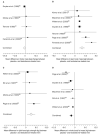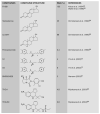Drug insight: Testosterone and selective androgen receptor modulators as anabolic therapies for chronic illness and aging
- PMID: 16932274
- PMCID: PMC2072878
- DOI: 10.1038/ncpendmet0120
Drug insight: Testosterone and selective androgen receptor modulators as anabolic therapies for chronic illness and aging
Abstract
Several regulatory concerns have hindered development of androgens as anabolic therapies, despite unequivocal evidence that testosterone supplementation increases muscle mass and strength in men; it induces hypertrophy of type I and II muscle fibers, and increases myonuclear and satellite cell number. Androgens promote differentiation of mesenchymal multipotent cells into the myogenic lineage and inhibit their adipogenic differentiation, by facilitating association of androgen receptors with beta-catenin and activating T-cell factor 4. Meta-analyses indicate that testosterone supplementation increases fat-free mass and muscle strength in HIV-positive men with weight loss, glucocorticoid-treated men, and older men with low or low-normal testosterone levels. The effects of testosterone on physical function and outcomes important to patients have not, however, been studied. In older men, increased hematocrit and increased risk of prostate biopsy and detection of prostate events are the most frequent, testosterone-related adverse events. Concerns about long-term risks have restrained enthusiasm for testosterone use as anabolic therapy. Selective androgen-receptor modulators that are preferentially anabolic and that spare the prostate hold promise as anabolic therapies. We need more studies to determine whether testosterone or selective androgen-receptor modulators can induce meaningful improvements in physical function and patient-important outcomes in patients with physical dysfunction associated with chronic illness or aging.
Figures





References
-
- Spillman BC, Lubitz J. The effect of longevity on spending for acute and long-term care. N Engl J Med. 2000;342:1409–1415. - PubMed
-
- Bhasin S, et al. Androgen effects on body composition. Growth Horm IGF Res. 2003;13(Suppl A):S63–S71. - PubMed
-
- Katznelson L, et al. Using quantitative CT to assess adipose distribution in adult men with acquired hypogonadism. AJR Am J Roentgenol. 1998;170:423–427. - PubMed
-
- Roy TA, et al. Interrelationships of serum testosterone and free testosterone index with FFM and strength in aging men. Am J Physiol Endocrinol Metab. 2002;283:E284–E294. - PubMed
-
- Baumgartner RN, et al. Predictors of skeletal muscle mass in elderly men and women. Mech Ageing Dev. 1999;107:123–136. - PubMed
Publication types
MeSH terms
Substances
Grants and funding
LinkOut - more resources
Full Text Sources
Other Literature Sources
Medical
